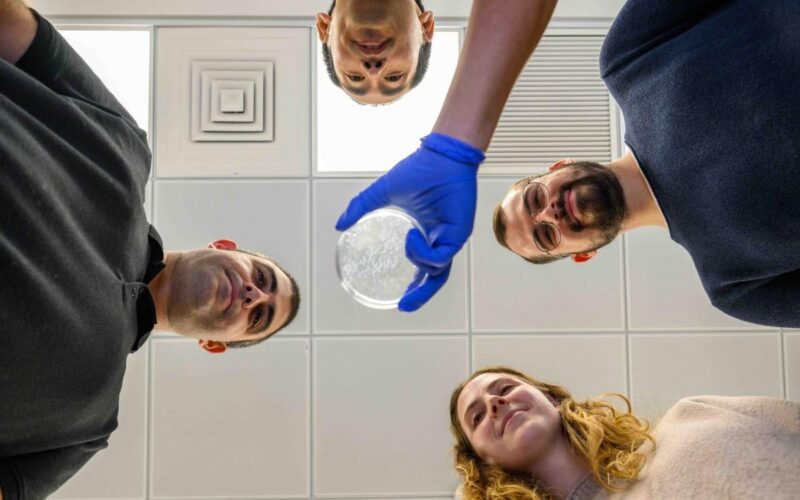
October 29, 2021
Jupiter’s Great Red Spot is up there with the rings of Saturn and the blue marble of Earth for solar system icon status. In a study published this week in Science, Weizmann Institute of Science researchers and their collaborators on NASA’s Juno mission to Jupiter, report that this spot – really a giant, persistent storm – extends to a depth of about 500 kilometres below the planet’s clouds, with a surprising parallel with Earth.
This revelation is among the mission’s findings being presented at a NASA press conference tonight and published in Science and in Geophysical Research Letters.
The Juno space probe, launched about a decade ago, entered Jupiter’s orbit in 2016. Even before that, Professor Yohai Kaspi’s team of Weizmann Institute’s Earth and Planetary Sciences Department had started exploring the possibility of using the mission’s data to determine the mass of the Great Red Spot.
“We proposed an ambitious experiment that wasn’t part of Juno’s original program, but we thought that with a flyby above the Great Red Spot dedicated to gravity measurements, it could work,” Kaspi explained.
The project relied on an innovative method developed by Kaspi and Dr Eli Galanti, a staff scientist in his team, for analysing the inner structure of planetary winds using gravity measurements. Dr Marzia Parisi, then a postdoctoral fellow in Kaspi’s lab and now a researcher at NASA’s Southern California-based Jet Propulsion Lab, which manages the Juno mission, undertook the planning of the complex experiment.
Its execution involved directing Juno to perform two passes around Jupiter designed for the experiment (out of a total of thirty-seven it has performed to date). Now, seven years after the original planning began and armed with a wealth of precise measurements of Jupiter’s gravity field, Kaspi’s team and their collaborators have managed to determine not only the mass but also the depth of the giant storm.
“The Giant Red Spot was discovered over two centuries ago, but up till now we’ve only known what it looks like from the outside,” Galanti said.
“Now we have, for the first time, revealed its structure and determined its depth.”
“To get an idea of its dimensions, if a storm of the same size started on the surface of Earth, it would extend all the way up to the International Space Station,” added Parisi, lead author of the Science paper.
Microwave measurements reveal surprising depth of storms
Kaspi’s research team took part in another Juno project, led by Juno’s principal investigator Dr Scott Bolton; its findings were also published in Science.
On one of Juno’s passes around Jupiter, the scientists rotated the probe so that its microwave measuring instrument would scan the climate phenomena beneath the planet’s clouds. This instrument is sensitive to temperature, providing a heat profile of six atmospheric layers, from the clouds down to 350 kilometres beneath. Storms that are much smaller than the Great Red Spot, though still larger than Earth’s greatest hurricanes, were found to extend dozens of kilometres below Jupiter’s clouds. This was a surprising discovery as the storms were not expected to extend this deep.
Jupiter’s atmospheric circulation cells resemble those on Earth
In yet another project also based on Juno’s microwave measurements, Kaspi’s team went beyond studying individual cyclones and vortices to explore Jupiter’s entire pole-to-pole thermal structure.
The scientists revealed that the thermal signal obtained across the entire stretch of atmosphere penetrated by the microwave instrument perfectly matched the distribution of the bands and zones observed on the surface of the planet’s clouds. Moreover, the microwave measurements provided information about Jupiter’s atmospheric concentrations of ammonia – a gas that, when it cools in the outer layers, creates the white zones familiar from images of the planet.
“When the atmosphere is opaque, this suggests the concentration of ammonia is high in that region,” said graduate student Keren Duer in Kaspi’s team, who led the study together with a fellow student, Nimrod Gavriel.
“The concentration of ammonia in different layers is governed by the direction of the wind, which draws the ammonia up or down,” Gavriel said.
In the past, Kaspi’s team had already shown that the high-velocity jet streams responsible for Jupiter’s iconic bands and zones extended downward from the clouds to a depth of about 3,000 kilometres. Those streams were known to run from east to west or from west to east. However, the planet’s north-south, and up-and-down circulation patterns were still unknown, and these patterns are vital to understanding the dynamics of the planet’s atmosphere.
The new interpretation of the ammonia data collected by Juno’s microwave instrument has now supplied evidence that the jet streams producing Jupiter’s bands and zones are parts of circulation systems that are similar to Earth’s atmospheric Ferrel cells.
Earth has two Ferrel cells – one in the southern, the other in the northern hemisphere – and they play an important role in the planet’s climate. Kaspi’s team found that on Jupiter – which is eleven times larger than Earth – there are sixteen Ferrel cells. And while on Earth these cells are known to be bounded by the ground, Jupiter – a gaseous planet – has no ground, and the thermal measurements conducted so far reach a depth of only 350 kilometres, so it’s still unknown where the bottoms of its Ferrel cells end.
This is the first direct and clear-cut evidence for the existence of such cells on a gaseous planet.
“It is possible that Jupiter’s magnetic field may perform the same function as does Earth’s ground, creating a boundary for the cells,” said Duer and Gavriel.
The new findings, including the newly discovered parallel between Earth’s and Jupiter’s circulation cells, provide unexpected insights into climate dynamics on Jupiter and other gaseous planets.
“Since Juno arrived at Jupiter’s orbit, we’ve been working like archaeologists, only instead of digging below ground, we’ve been exploring what happens below clouds,” Kaspi concluded.





